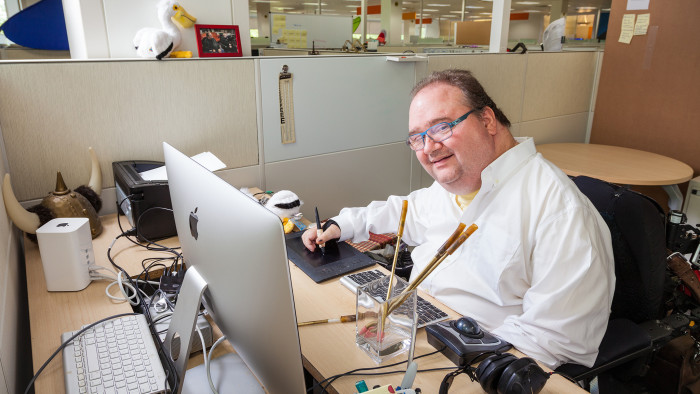Adaptations that build a welcome in the office for all

Roula Khalaf, Editor of the FT, selects her favourite stories in this weekly newsletter.
Before Pete Denman started his first morning working for Intel, the US computer chipmaker, the company asked him precisely what height he needed his desk. When he rolled his electric wheelchair into position on his first morning at the company’s site at Hillsboro, Oregon, he was gratified to find it exactly at the right level.
That attention to detail is one of many welcome surprises that Mr Denman, 50, has experienced in nearly 13 years of working for his employer, where he currently works on new types of user interface for the company’s Intel Labs division, which develops technology for the long-term future.
Among the projects he has undertaken at the division was work to improve custom-built systems designed for Stephen Hawking, the recently deceased disabled theoretical physicist, who communicated using a voice synthesiser.
The adaptation to desk height is one of a suite of changes that the company has made to accommodate Mr Denman, who broke his neck aged 20 and is not only quadriplegic but also dyslexic.
In his current workspace, where workers are arranged in cubicles, Mr Denman has a larger space than his colleagues to ensure his wheelchair fits in easily. Intel now uses as standard desks that can be instantly adjusted to a range of heights, meaning the space works well whether Mr Denman arrives in his normal wheelchair or his spare, which is a slightly different height.
The changes that Intel has made to accommodate Mr Denman illustrate the efforts of many employers to enable staff requiring extra support to work alongside able-bodied colleagues.
Such adjustments stem from years of legislation in most parts of the industrialised world outlawing discrimination against such workers. In the US, the Americans with Disabilities Act, was passed in 1990 while in the UK the most important legislation is the Equality Act 2010. Both enshrine the idea that employers are obliged to make “reasonable” adjustments or accommodations to suit disabled employees.
The concept means, according to David Bonnett, an architect based in London who is himself disabled, that architects should work to ensure buildings meet the basic standards and then work on the assumption employers will have to make adjustments to suit disabled employees.
“Getting in, reception, WCs and escape — those are the rudiments,” Mr Bonnett says. “Everything else — is the lighting too bright, is the room too noisy, am I near the toilet — all of that is in the box called reasonable adjustments.”
Under that system, employers should check when taking on a new disabled employee — or when an existing employee becomes disabled — what reasonable steps can be taken to accommodate his or her needs. Most adaptations turn out to cost nothing, or to be relatively cheap, Mr Bonnett says.
Legislation has had a remarkable effect across the world in pushing building owners to adapt their premises to allow disabled people easier access.
Mr Bonnett says the Westminster headquarters of the UK’s Institute of Civil Engineers used to direct disabled people round to the building’s goods entrance, at the rear. It now has a graceful set of lifts at the front door, in keeping with the grand Edwardian building’s exterior.
Immediately across Great George St, the UK government’s Treasury building has had a new door cut into a former window by its entrance to allow wheelchair access.
Such changes, Mr Bonnett points out, turned out to be popular among people in general. “Every business in London, or certainly the majority, contains adaptations to accept wheelchair users,” he says. “But they have a wider benefit, for people coming with children in buggies, for example. It’s switching away from being specialised into what we call mainstream design.”
Both Mr Denman and Mr Bonnett, however, point to another problem as being the next battleground for disabled people — the journey to work.
There remain significant problems with the accessibility within cities for people with mobility problems — older parts of the London Underground, for example, remain inaccessible.
Mr Denman, who cannot drive, says he is looking forward to the day when a driverless car will be able to take him on the journey from his home in downtown Portland to the office to increase his independence.
Mr Bonnett says the benefit to society of improving access to work for disabled people is significant though not obviously quantified. “We don’t have research into the benefits . . . of somebody feeling happy because they’re working rather than not working, somebody paying their taxes rather than drawing benefits, somebody’s sense of wellbeing improving,” he says.
Mr Denman himself, meanwhile, demonstrates the benefits for a business of unlocking the talents of disabled people. “I have to think completely outside the box,” he says. Work on touchscreen technology remains a personal and professional challenge. “I have to really internalise how somebody is going to be using it and really try to empathise with it.”

Comments